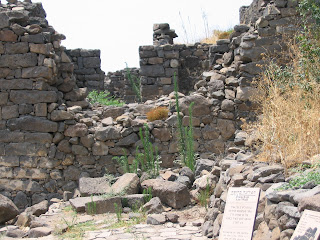A message from the ruins of Gamla
What do ancient Gamla's archaeological finds help teach us about Mishnaic prose? Take a closer look at this hill, site of the ancient battle of the Israelites in the Great Revolt against the Romans, circa. 67 CE.

Masechet Shabbat includes many mentions of Eruv issues, that is the public, private and other spaces we live in, and their direct influence on whether or not we can carry, throw or otherwise move an object through that space. Interestingly, the Mishnaic town included spaces that to the modern man must be explained, as we are less familiar with a 'carmelit' than they were.
In fact, our sages did not always know how to relate to the described spaces, or solutions. On Daf קי"ז and many others throughout the Masechet and in Euruvin as well, some concepts remained a mystery, seldom explicitly understood. Take the small but powerful Lechi, for example. Yes, we know it's at least ten tefachim (approx 80 cm) tall and helps turn a 'mavoi' into an area permissible for carrying.
But what's a mavoi? Take a look at this thin passageway for a better idea.
Lo and behold - in the ruins of the second-temple period city of Gamla, uncovered by archaeologist giant Shemaryahu Gutman, near this breach of the walls, we find our very own Lechi!
Ten tfachim high, the Lechi, or post, stands in the Mavoi, or passageway, allowing the Israelites of Gamla to carry their belongings on Shabbat without worry. A messenger from the past, coming to personify the Mishnaic passages that were vaguely understood until we returned to our land and dug up our heritage...





Comments
Post a Comment